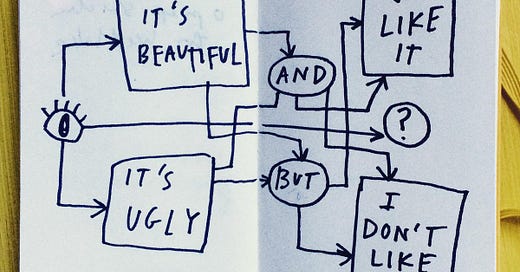Hey y’all,
I doodled this chart in my notebook after reading the essay “It’s beautiful, but I don’t like it” in playwright Sarah Ruhl’s terrific book, 100 Essays I Don’t Have Time To Write.
Here is the essay in full:
Recently, my son said to me after seeing a ballet on television: “It’s beautiful but I don’t like it.” And I thought, Are many grown-ups capable of such a distinction? It’s beautiful, but I don’t like it. Usually, our grown-up thinking is more along the lines of: I don’t like it, so it’s not beautiful. What would it meant to separate those two impressions for art making and for art criticism?1
It took me a while to connect it to a bit by W.H. Auden (from his “commonplace book,” A Certain World) that I first came across in Alan Jacobs’ excellent book, The Pleasures of Reading in an Age of Distraction:
As readers, we remain in the nursery stage so long as we cannot distinguish between Taste and Judgment, so long, that is, as the only possible verdicts we can pass on a book are two: this I like; this I don’t like.
For an adult reader, the possible verdicts are five: I can see this is good and I like it; I can see this is good but I don’t like it; I can see this is good and, though at present I don’t like it, I believe that with perseverance I shall come to like it; I can see that this is trash but I like it; I can see that this is trash and I don’t like it.
Keep reading with a 7-day free trial
Subscribe to Austin Kleon to keep reading this post and get 7 days of free access to the full post archives.





